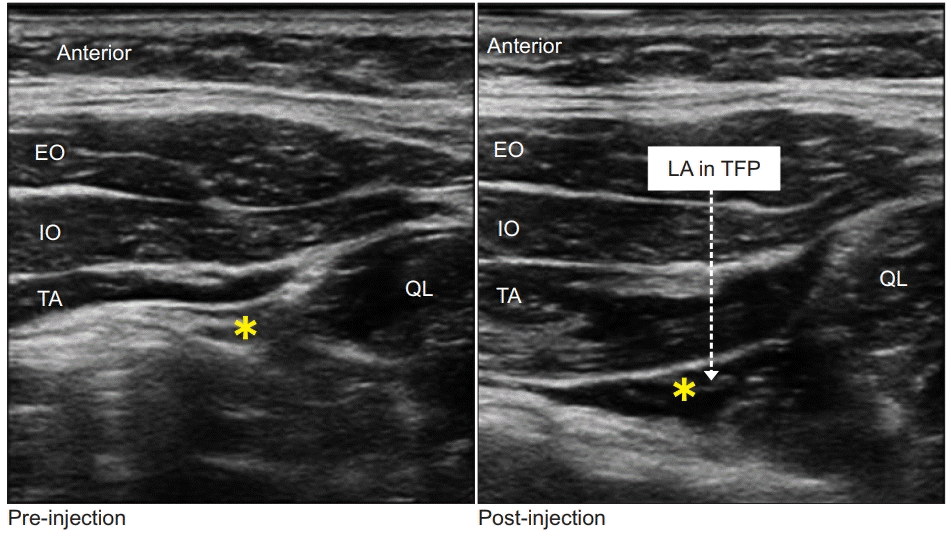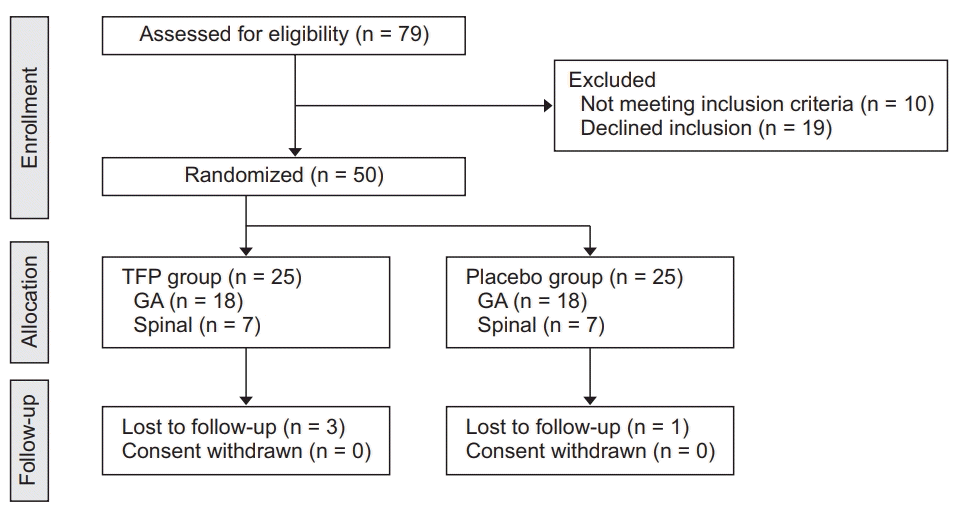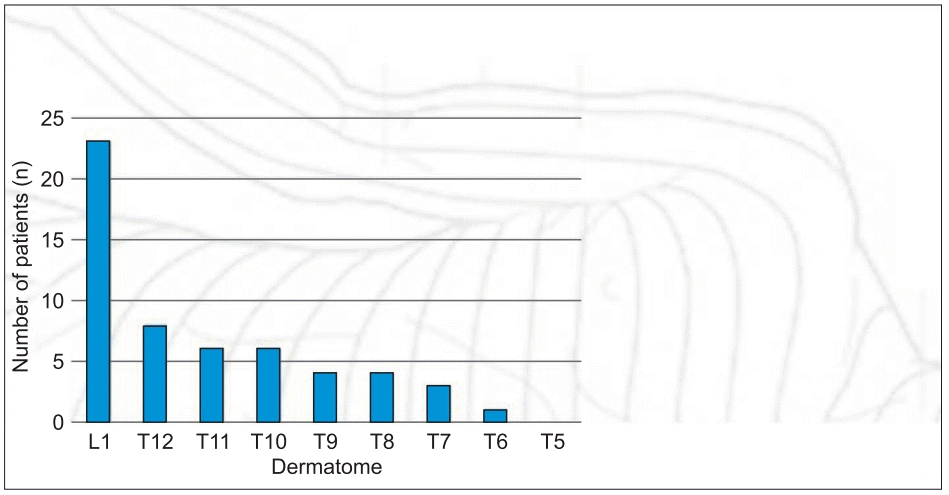1. Morgan SJ, Jeray KJ, Saliman LH, Miller HJ, Williams AE, Tanner SL, et al. Continuous infusion of local anesthetic at iliac crest bone-graft sites for postoperative pain relief. A randomized, double-blind study. J Bone Joint Surg Am. 2006; 88:2606–12.
2. DeOrio JK, Farber DC. Morbidity associated with anterior iliac crest bone grafting in foot and ankle surgery. Foot Ankle Int. 2005; 26:147–51.

3. Todd BD, Reed SC. The use of bupivacaine to relieve pain at iliac graft donor sites. Int Orthop. 1991; 15:53–5.

4. Cowan N, Young J, Murphy D, Bladen C. Double-blind, randomized, controlled trial of local anesthetic use for iliac crest donor site pain. J Neurosci Nurs. 2002; 34:205–10.

5. Blumenthal S, Dullenkopf A, Rentsch K, Borgeat A. Continuous infusion of ropivacaine for pain relief after iliac crest bone grafting for shoulder surgery. Anesthesiology. 2005; 102:392–7.

6. Singh K, Phillips FM, Kuo E, Campbell M. A prospective, randomized, double-blind study of the efficacy of postoperative continuous local anesthetic infusion at the iliac crest bone graft site after posterior spinal arthrodesis: a minimum of 4-year follow-up. Spine (Phila Pa 1976). 2007; 32:2790–6.
7. Brull SJ, Lieponis JV, Murphy MJ, Garcia R, Silverman DG. Acute and long-term benefits of iliac crest donor site perfusion with local anesthetics. Anesth Analg. 1992; 74:145–7.
8. Hebbard PD. Transversalis fascia plane block, a novel ultrasound-guided abdominal wall nerve block. Can J Anaesth. 2009; 56:618–20.

9. Chin KJ, Chan V, Hebbard P, Tan JS, Harris M, Factor D. Ultrasound-guided transversalis fascia plane block provides analgesia for anterior iliac crest bone graft harvesting. Can J Anaesth. 2012; 59:122–3.

10. López-González JM, López-Álvarez S, Jiménez Gómez BM, Areán González I, Illodo Miramontes G, Padín Barreiro L. Ultrasound-guided transversalis fascia plane block versus anterior transversus abdominis plane block in outpatient inguinal hernia repair. Rev Esp Anestesiol Reanim. 2016; 63:498–504.

11. Choudhary J, Mishra AK, Jadhav R. Transversalis fascia plane block for the treatment of chronicpostherniorrhaphy inguinal pain: a case report. A A Pract. 2018; 11:57–9.
12. Tulgar S, Serifsoy TE. Transversalis fascia plane block provides effective postoperative analgesia for cesarean section: New indication for known block. J Clin Anesth. 2018; 48:13–4.

13. Punekar IR, Koltz PF, Smith DI, Tran NH, Chibber AK, Sbitany H, et al. The evolution of iliac bone graft donor site analgesia in cleft patients: transversus abdominis plane block is safe and efficacious. Ann Plast Surg. 2018; 81:441–3.
15. Melzack R. The short-form McGill Pain Questionnaire. Pain. 1987; 30:191–7.

17. Goulet JA, Senunas LE, DeSilva GL, Greenfield ML. Autogenous iliac crest bone graft. Complications and functional assessment. Clin Orthop Relat Res. 1997; (339):76–81.

18. Richebé P, Capdevila X, Rivat C. Persistent postsurgical pain: pathophysiology and preventative pharmacologic considerations. Anesthesiology. 2018; 129:590–607.
19. Chiono J, Bernard N, Bringuier S, Biboulet P, Choquet O, Morau D, et al. The ultrasound-guided transversus abdominis plane block for anterior iliac crest bone graft postoperative pain relief: a prospective descriptive study. Reg Anesth Pain Med. 2010; 35:520–4.
20. Sondekoppam RV, Ip V, Johnston DF, Uppal V, Johnson M, Ganapathy S, et al. Ultrasound-guided lateral-medial transmuscular quadratus lumborum block for analgesia following anterior iliac crest bone graft harvesting: a clinical and anatomical study. Can J Anaesth. 2018; 65:178–87.

21. Børglum J, Jensen K, Christensen AF, Hoegberg LC, Johansen SS, Lönnqvist PA, et al. Distribution patterns, dermatomal anesthesia, and ropivacaine serum concentrations after bilateral dual transversus abdominis plane block. Reg Anesth Pain Med. 2012; 37:294–301.

22. Lee TH, Barrington MJ, Tran TM, Wong D, Hebbard PD. Comparison of extent of sensory block following posterior and subcostal approaches to ultrasound-guided transversus abdominis plane block. Anaesth Intensive Care. 2010; 38:452–60.

23. Chin KJ, McDonnell JG, Carvalho B, Sharkey A, Pawa A, Gadsden J. Essentials of our current understanding: abdominal wall blocks. Reg Anesth Pain Med. 2017; 42:133–83.
24. Lee S, Goetz T, Gharapetian A. Unanticipated motor weakness with ultrasound-guided transversalis fascia plane block. A A Case Rep. 2015; 5:124–5.

25. Ueshima H, Hiroshi O. Incidence of lower-extremity muscle weakness after quadratus lumborum block. J Clin Anesth. 2018; 44:104.
26. Manatakis DK, Stamos N, Agalianos C, Karvelis MA, Gkiaourakis M, Davides D. Transient femoral nerve palsy complicating “blind” transversus abdominis plane block. Case Rep Anesthesiol. 2013; 2013:874215.

27. Walker G. Transversus abdominis plane block: a note of caution! Br J Anaesth. 2010; 104:265.






 PDF
PDF Citation
Citation Print
Print





 XML Download
XML Download